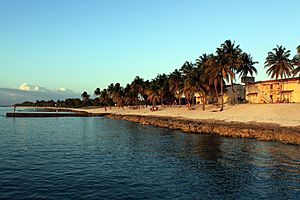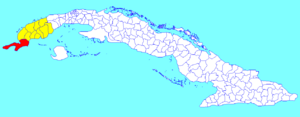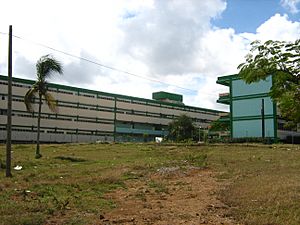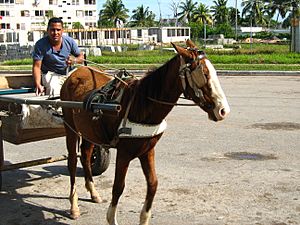Sandino, Cuba facts for kids
Quick facts for kids
Sandino
|
|
|---|---|

Maria la Gorda
|
|

Sandino municipality (red) within
Pinar del Río Province (yellow) and Cuba |
|
| Country | Cuba |
| Province | Pinar del Río |
| Area | |
| • Municipality | 1,718 km2 (663 sq mi) |
| Elevation | 10 m (30 ft) |
| Population
(2022)
|
|
| • Municipality | 35,437 |
| • Density | 20.627/km2 (53.423/sq mi) |
| • Urban | 22,314 |
| • Rural | 13,123 |
| Time zone | UTC-5 (EST) |
| Area code(s) | +53-82 |
Sandino is a town and a municipality in the Pinar del Río Province of Cuba. It is located near the coast. Fishing is a very important part of the local economy. Sandino is also the main entry point to the Guanahacabibes Peninsula. This area is a special UNESCO Biosphere Reserve, known for its unique nature.
Contents
History of Sandino
The municipality of Sandino got its name from Augusto César Sandino. He was a famous revolutionary from Nicaragua. In January 2019, something special happened in Sandino. The Sacred Heart of Jesus Catholic Church opened. It was the first new Catholic church to open in Cuba since the Cuban Revolution.
Geography of Sandino
Sandino is located in the very western part of Cuba. It shares borders with the areas of Guane and Mantua. The westernmost tip of Sandino is Cape San Antonio. This cape is found on the Guanahacabibes Peninsula.
The municipality includes many small villages and communities. Some of these are Babineyes, Bolívar, Cayuco, Cortés, Covadonga, La Bajada, La Conchita, La Fe, La Furnia, La Grifa, Las Martinas, La Yana, Las Tumbas, Los Cayuelos, María la Gorda, Marina Cabo San Antonio, Roncali, San Julián, Santa Barbara, Valle San Juan, and Veinte de Mayo.
Population in Sandino
In 2022, the municipality of Sandino had a population of 35,437 people. The total area of Sandino is about 1,718 square kilometers (663 square miles). This means there are about 21 people living in each square kilometer (54 people per square mile).
Education in Sandino
Sandino has several high schools, called secundarias in Spanish. Students from many towns, like San Juan y Martinez, San Luis, and Guane, come to study here. This covers a large area of about 70 kilometers (43 miles).
Sandino is also an important center for the Cuban university program called ELAM. ELAM stands for Escuela Latinoamericana de Medicina, which means Latin American School of Medicine. The Cuban government has built many medical schools here. Many students come from countries in Latin America and the Caribbean. These include Guyana, Argentina, Ecuador, Nicaragua, El Salvador, Bolivia, Peru, Suriname, Dominica, St. Lucia, Belize, Jamaica, Haiti, St. Vincent, Antigua, Solomon Islands, Nauru, Grenada, and Barbados. More countries like Tuvalu and the Philippines are expected to join.
There are several ELAM campuses in Sandino. Most campuses have students from just one country, with 300 or more students. However, some campuses, like ELAM 10, have students from more than 15 different countries. These campuses are smaller, with up to 500 students in total.
Transportation in Sandino
There are not many roads in Sandino. Most of the roads do not even have names. People identify locations by the farms they lead to. Regular buses travel to the town of Sandino and other places like Guane, Isabel Rubio, and Pinar del Río.
It is common to see traditional ways of transport here. These include oxcarts, donkey-carts, and horse-driven carts. Many people have to walk long distances to find a ride. Hitchhiking is also very common in these areas.
The national road called Carretera Central begins in the village of La Fé, which is part of Sandino. This road also passes through the town of Sandino itself.
Famous People from Sandino
- José Contreras (born 1971), a baseball player
- Daysbel Hernández (born 1996), a baseball player
Images for kids
See also
 In Spanish: Sandino (Cuba) para niños
In Spanish: Sandino (Cuba) para niños





